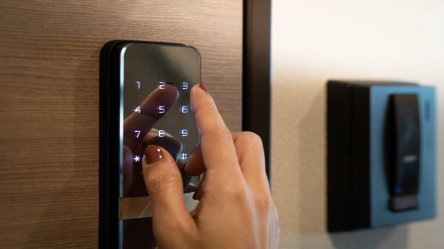If you are on the fence about self-guided tours at your property, take heart. The benefits of self-guided showings are plenteous, and you can still provide many benefits of agent-led tours. Additionally, self-guided experiences alleviate many frustrations for leasing office staff and prospects. Read on to learn how you can benefit from making the switch. The benefits of agent-led showings Multifamily professionals often prefer guided tours for a few great reasons. Leasing agents learn more about prospects during the tour. They can then use that information to determine which unit, amenities, and community features will most appeal to the prospects. Of equal importance, leasing agents build rapport with prospects which is a vital part of the sales process. When tours are booked through the office and led by an agent, property managers may feel more at ease. They know exactly who will be on the property and when. When prospects are accompanied by an agent, the property manager knows the guests will see the best of the community and have all their questions answered. Self-guided tours can offer many of the same benefits—and more! Agents can still connect with prospects before the showing. They can use that information to highlight areas of interest for prospects. Additionally, self-led tours can be accompanied by audio or written guides, so prospects don’t miss out on the most important details of the unit, community, and neighborhood. Technology also addresses security concerns. Through the tour scheduling app, prospects receive a unique code that is only functional during their tour time. Property managers will still have a clear idea of who is touring the unit and when. There are several unique benefits to self-guided tours as well: The benefits of self-guided tours Practice social distancing without losing business. Social distancing...
Data-Driven Insights
Educational Online Content
Want to learn how to create digital content that engages professional learners? The first step is to understand the preferences and habits of adult learners. The 2019 BrightTALK Benchmarks report analyzes data on webinars, online courses, videos and other digital modalities to explore how professionals engage with content. How do professionals engage with content and when? More than 77% of those surveyed spend 2 or more hours per week on professional growth. Nearly 55% engage with webinars regularly, with 6% watching daily, more than 48% watching weekly, and more than 31% watching webinars monthly. Though 91% of respondents opt for webinars, other educational formats performed well. About 68% got information from short videos, 60% from articles, and 54% online courses. The ability to view content on demand was the highest ranked format feature, followed by the ability to watch a recording later. Professionals preferred to engage with live content hosted at 8am in Europe and North America. Though mornings were also popular in the APAC region, afternoons performed equally as well. Weekday events performed consistently well worldwide. Viewers in North America favored Tuesday and Thursday slightly more than other weekdays. Understanding the most favorable times to host live events helps growing organizations successfully schedule content. Discover how Roscoe Properties uses eLearning to onboard new employees during periods of rapid growth. What do professionals value in content? Professionals access digital content for a variety of reasons, but four categories attracted the broadest range of participants. About 80% of respondents accessed online content to acquire a new body of knowledge or skills followed by 78% who desired to improve their quality of the work. Tips, tricks, and best practices caught the interest of 70% of respondents and industry trends and predictions interested 62% of them. When...
Spring Marketing
RentCafe & Social Media
As the snow thaws and daylight lingers through the evening, your residents will be itching for fun ways to get outdoors and spend time with loved ones. Catch their attention with your community events! This guide will offer quick and simple steps for launching your events towards success. Before the Event After you’ve planned the event, you’ve got to get the word out. Use Yardi RentCafe to create a blog post about the event. In the post, provide helpful details such as: Date, time and location Admission costs, include an early bird discount to create urgency and motivate the sale Number of non-resident guests that may accompany residents Relevant age restrictions Parking provisions Recommend attire or dress code Details about any items that guests should bring Don’t forget to give the event plenty of personality! Do this through the tone of your text and the Featured Image that you select on the blog post. Once the blog post is complete, use RentCafe to connect Facebook and promote your event. You may choose to pin the post to the top of your newsfeed so that all new and returning visitors will see it. Next, create at least one new visual per week that you can use to promote the event on social media (in addition to your blog post). Fresh visuals are important because they may capture the attention of residents who did not respond to the Featured Image on the blog post. The visuals can be videos, illustrations, or pictures with text. In the latter, limit the text to 20-30 percent of the total image surface area. If an image is too wordy, it will be ignored. Distribute these images on your preferred social media platform(s) each week to spread the word of your...
Digital Conversations
Chatbots in Multifamily
Imagine never picking up the phone to answer prospects’ questions yet still receiving stellar reviews for customer service. Can you see a future where residents only visit the leasing office for friendly conversation? All their questions, concerns, and feedback are addressed without consuming staff time. Chatbots are bringing these seemingly unrealistic expectations to reality—and it’s time for multifamily to reap the benefits. What’s a chatbot and why should I care? A chatbot is an interactive application that relies on artificial intelligence to assist humans. Quality chatbots mimic human communication by using personable language when engaging with users via websites, apps, and text messages. Multifamily housing providers use chatbots to reduce operational costs while improving responsiveness to clients’ needs. Advanced chatbot auto-response systems promptly assist clients without human intervention. Chatbots can guide prospects through the leasing process, assist residents with online bill pay, submit maintenance requests, and issue lease renewals without consuming a second of a leasing agent’s time. As a result, chatbot users can experience improved resident satisfaction and retention. Your competition is likely benefiting from this technology At the end of 2018, about 66.4 million chatbots were in use in the US. That’s a 40 percent boost over 2017’s data. The implementation rates continue to climb. A Spiceworks survey revealed that 40 percent of companies employing more than 500 people implemented one or more chatbots over corporate mobile devices this year. About 80 percent of marketers will implement a chatbot by 2020, estimates Oracle. The popularity of chatbots stems from their effectiveness. They are responsive, patient, and impartial. According to NICE inContact’s 2018 CX Transformation Benchmark, 33 percent of consumers report that chatbots made issue resolution faster. Users also appreciate the responsiveness, convenience, and reliability of chatbots. AI communication is more efficient than email yet still maintains a written record of the conversation that can be emailed to users. Chatbots are more convenient than phone calls because they offer assistance 24/7. This combination of features has helped to establish trust between users and AI. Trust matters. Millennials favor chatbots though adults of all ages are increasingly comfortable with chatbot interaction, even for expensive purchases like an apartment. A Drift survey suggests that 13 percent of adults purchased at least one expensive item using a chatbot and 27 percent have purchased daily necessities. A new-ish technology is already improving Technically, the first chatbot was created in 1966. It felt very much like talking to a robot that had the conversational and comprehension skills of a toddler. But that noble program paved the way for the powerhouses of today. Modern chatbots are equipped with machine learning which makes them more sophisticated than their predecessors—and their technology is improving by the second. When artificial intelligence is paired with machine learning, a chatbot gathers data from each interaction with users and analyzes that data to improve future experiences. Chatbots learn, in a sense, to be more helpful and more natural in their engagement with humans. For example, a chatbot can answer most questions about a property or unit such as square footage, layout, rent rates, pet policies, and amenities. When they encounter questions that they cannot answer, they send a report to operators and improve their services in the future. Each interaction improves future interactions. Additionally, chatbots deliver information promptly and as frequently as prospects request it. Unlike humans, chatbots can repeat information and receive a multitude of questions without a change in temperament or feeling pressed for time. As a result, customer service scores will not be affected by a representative’s mood or tone. What does the future look like? Business Insider reports that 80 percent of enterprises will use chatbots by 2020. Organizations benefit from improved communication between companies and consumers without increasing the manpower needed to handle rote tasks. AIs ability to communicate and handle tasks will become more sophisticated. Natural language processing enhances the usage of chatbots in...
Websites that Wow
Standing out in senior living
The first tour a prospect takes is not at your community. It’s on your website. Nearly 90% of senior living prospects will visit a community’s website before they ever reach out. For senior living marketers, that means the community’s online presence needs to be as impressive as its physical campus is. We’re talking clean, modern designs. Engaging content. Interactive floorplans. These elements are essential for educating and converting visitors to prospects. But building out these features is easier said than done. Not many senior living providers have staff with web expertise or the resources on hand to run such a crucial project. That’s where Yardi can help. Our RENTCafé team doesn’t just work on online portals for residents and family members. They also have a team of creative professionals who design and develop senior living websites for providers. That includes community-specific websites as well as brand-level corporate sites, all of which can be managed by the senior living marketer from a single solution. Senior living website themes galore To make things simple, we’ve already built out over 70 website designs for senior living providers to choose from. There’s a wide range of styles to fit any market, and the themes are configurable too. Unlimited pages are included with any RENTCafé website, allowing marketers to promote their values, activities or anything else about their communities. If the senior living community wants something uniquely theirs, our RENTCafé creative team can design a full theme to represent the brand’s vision. The team works together directly with the senior living provider to determine goals, feature requirements, content needs and, of course, the look and feel. Mobile optimized for modern devices Websites used to have an entirely separate site dedicated for viewing on mobile. But as Google has updated...
Breed Restrictions
SEO + SEM for flexible pet policies
Did you know that “apartments with no breed restrictions” is a popular Google search query in most metropolitan areas? The trend extends to many secondary markets as well. Properties without breed restrictions can capitalize on a flexible pet policy—if you use strategic SEO. When high-risk isn’t a mandatory “no” Insurance companies’ classification of “high-risk” pets is the result of actuarial and claims data. Over time, the insurance companies analyze data regarding pet-related claims. Breeds that appear in claims the most (thus costing the insurance company the most) will appear on the high-risk list. Commonly listed breeds include pit bulls, Doberman pinschers, rottweilers, German shepherds, mastiffs, Great Danes, Siberian huskies, Alaskan malamutes, and wolf-hybrids. These breeds are large dogs (above 45lbs) which is why some apartment communities restrict by size rather than listing specific breeds. The congregated lists of insurance companies may impact local and state legislation. More than 700 U.S. cities have authorized breed-specific laws. As a property owner, you do not have the flexibility to opt out government-mandated breed restrictions. However, it is often optional for you to accept and enforce your insurers recommend breed restrictions. If you opt to waive the restriction, your property is among a highly sought-after group of apartments in major metropolitan areas. The best of both worlds: accepting all breeds with additional insurance protection If you are in a renters’ market with tough competition, a flexible pet policy could work in your favor. When coupled with additional insurance on high-risk pets, you can address insurance concerns without turning away quality renters. In addition to required renters insurance, consider a mandatory liability policy that covers large breed owners with at least $300,000. The policy may also list the landlord as an additional insured member. Since few communities accept large...
Senior Living Marketing
Getting Found Online
From clothes to cars to a place to call home, every search now starts online. For senior living providers, that means their community must be easy to find in Google results and on social media. Otherwise, prospects may never discover them. But how do you rank high on Google? Or get featured in Facebook feeds? What steps should you take to compete online? The right digital marketing strategy makes all the difference, but building out a plan – and sticking to it – takes dedicated resources, consistent research and lots of elbow grease. Especially at the start, it’s easy to get overwhelmed. Fortunately, senior living providers don’t have to go it alone. Our RENTCafé Reach services help senior living communities get found online. We have senior living marketing experts who take care of search engine optimization, pay-per-click advertising, social media management and more to ensure there are always new prospects knocking. The way it works is simple. We take the time to understand a community’s goals, then formulate a full marketing plan. Senior living providers can opt in for all our services or just one. Either way, we regularly share analytics and finetune the strategy. Here’s a closer look at how RENTCafé Reach helps communities stand out in today’s digital marketplace: Increased traffic with search engine optimization What works and what doesn’t for SEO rarely stays the same. As soon as the industry catches up with one of Google’s algorithm changes, Google switches how search results rank in ways that aren’t fully clear. Yardi is a Google Premier Partner, and our RENTCafé staff work to stay on top of the latest best practices and guidelines. From website audits to content creation to local business listings, we build authority and engagement to keep communities at the top of the search results. More clicks with pay-per-click advertising Paid ads on search engines target people with high intent — that is, quality leads. They’re typing keyword phrases like “local retirement home” or “best assisted living near me,” searches where any senior living provider would want to show up front and center. Our RentCafe Reach team members are certified AdWords specialists with years of digital marketing experience. We run ad campaigns based on occupancy needs and then analyze the results to continually improve ROI. Marketing spend is easily managed through a simple dashboard so plans stay within budget. Engaged prospects with social media posting Baby boomers are the next generation of senior living residents. They’re also unlike any generation of seniors that have come before. They’re technology adopters, avid smartphone users and social media posters. In fact, more than 85% of boomers use social media at least once a day, and they’re also the fastest-growing age group on Instagram. The same RENTCafé Reach experts who optimize our clients’ sites and run their PPC campaigns also manage the social media side of things. Since we have intimate knowledge of the communities, we can create a personality that builds brand recognition and engages prospective residents. Greater credibility with reputation management You may think online reviews are important, but you may not realize just how important they’ve become. According to research, 84% of people trust online reviews as much as they do personal recommendations. This is even more significant in an industry like senior living where referrals are one of the strongest sources of new move-ins. Our RENTCafé Reach team monitors reviews, handles potentially negative posts and encourages more positive comments across channels like Google, Yelp and Facebook. We make sure our responses are timely and professional, but we also give clients the opportunity to review, edit or reject the replies to reflect their brand’s voice. Interested in learning more about RENTCafé Reach? Get in touch to see how we can help your own community expand its digital marketing footprint and draw in new...
3 Advanced Tips
Lead Tracking and Recovery
The cost of a lost lead varies for each organization. Kaplan Real Estate Education estimates that the average cost of a lead ranges from $50 and $60. The total cost of acquisition is at least $3,000. That’s marketing spend, time, and potential revenue wasted. The 3 tips below for capturing and recovering leads can help you make the most of your marketing dollars. Avoid lost leads with advanced CRM Advanced customer relationship management (CRM) software equips you with everything that you need to capture leads, hone your marketing strategy, and reduce lost leads. Your software should automate several tasks: the system uses call tracking numbers to identify your lead sources. Multi-point IVR phone trees can then route calls for improved customer service. Also within that first contact, the software makes it easy to log prospect data. Callers get the assistance that they need, and you can instantly create a profile for them. You can then use that accurate data to immediately follow-up or schedule future contact. Customizable automated correspondences within the software enable leasing agents to stay on prospects’ radars without less time spent on writing messages and making calls. When it is time for a live call, meeting or tour, automatic appointment reminders via email and text decrease the chances of missed opportunities. These reminders are sent to prospects and leasing agents through the CRM system. You can access reminders and other automated services on a personalized dashboard. Scheduled daily tasks, follow-ups, and other pertinent tasks are located on a single dashboard. The CRM dashboard makes its easier for you to nurture each lead. While you’re going through your due diligence, your multi-source attribution software runs in the background, analyzing your lead sources and conversions. Its analytics can help you decide where to...
Smart SMS Marketing
Texting Senior Living Prospects
You know how the stereotype goes. “Older people don’t use technology.” “Smartphones are too complicated for seniors.” “A flyer or a phone call is the only option.” Reality, as it turns out, begs to differ. According to an AARP survey, over 90 percent of older adults use technology to stay connected. And among those surveyed, text messaging has overtaken email as the method of choice for communication — 86% say they regularly text with friends and family. Clearly, today’s seniors are on board the technology bandwagon. The question now is, are your senior living sales counselors on board as well? SMS text messaging for senior living marketing is not new, but it’s quickly growing in prominence as more and more providers recognize its effectiveness. Text messages have open rates as high as 98%, while emails hover around 20%. If you’re not texting your prospective residents, you’re missing real opportunities to connect. But before you dive in and start sending texts left and right, take note. There are laws in place that regulate what’s allowed, and some property management businesses have already landed themselves in hot water. What’s the law on SMS text messaging for marketing? The Telephone Consumer Protection Act protects people from unwanted communications from any business. That means service providers must receive prior express written consent before cold calling or texting. And they can’t make agreeing to receive these marketing messages a condition for moving in or otherwise purchasing services. So how do you stay on the right side of the law? How do you ensure you’ve gotten permission from your senior living prospects to send them marketing texts? SMS text messaging in Yardi Senior CRM Yardi Senior CRM helps senior living providers manage their entire sales and marketing process — including...
Efficient Conversions...
How to Nurture Leads
According to Gleanster, only 25% of your marketing leads are prepared to buy. About 50% of leads enter a sales funnel undecided. That leaves a noteworthy 50% of leads that are dropped or go cold. Improving how you nurture leads and how to streamline that process can help you achieve more conversions and see greater returns on your marketing dollars. First step: optimize your first contact Making the most of your first contact with a lead is crucial to nurturing that relationship and prompting the conversion. At the widest part of the sales funnel, you’re putting in the legwork of lead generation. Your brand is making an impression on prospects via ads, listings, and other marketing initiatives. Towards the middle of the funnel, your prospects are showing interest. They’re responding to your marketing strategy. Perhaps they’ve filled out a contact card or visited the property. That first contact is essential. Use robust customer relationship management (CRM) software to store prospect contact information. In addition to traditional data such as phone and email, also request social media handles. Even if you don’t “friend” each prospect, you gain a better insight on their preferred platform for social media marketing. It is equally important to record lead attribution. That’s how the prospect found you such as the social media platform, website, or ad that convinced them to make contact. Getting this information will help you identify the highest quality lead sources and focus your future marketing dollars accordingly. Learn how to optimize multi-source lead attribution. Be sure that you’re entering prospect data into a CRM system that integrates with your property management software. This step improves efficiency by eliminating multiple points of data entry for the same prospect. It also decreases the likelihood of duplicate entries and...
5 Social Media Strategies
Get Ready for 2020
Social media platforms and technologies have redefined how multifamily managers engage with customers to attract, convert and retain residents. According to one survey, people spend one-seventh of their time on social media. In a crowded online environment, does your corporate or property social media strategy have what it takes to stand out and get noticed? Get ready for 2020 with these five smart social media strategies. Plan for the future by looking to your past. By analyzing current social performance data, setting realistic goals, and planning your social content calendar ahead of time, you’ll be set up for success in 2020. Get started: Do a social media audit Set your goals for 2020 Map out your path with this social media planning guidebook Get your proposal ready And if you’re new to social media marketing, here’s a great checklist on how to get started. Beat the algorithms. Multifamily marketers are competing with crowded social platforms and everchanging algorithms. Get a head start on 2020 by considering these strategies: New mediums, such as 3D photos, 360-degree videos and Facebook Live, are incentivized by Facebook, so being an early adopter is a smart move. This applies to other social networks too. Have you considered TikTok or Snapchat? As the saying goes, the early bird gets the worm. Those early to adopt can benefit from incentives like higher visibility and increased engagement rates. Investing in quality photography across your social media accounts and website can benefit your brand by showcasing your resident culture in a highly visual way. Not only do high-quality photos and video perform better, but they also provide a glimpse of the experiences offered at your community. Consider hiring a professional or purchasing equipment to create high-quality photos. Learn from top multifamily marketers and digital marketing experts at the 2020 Multifamily Social Media Summit. On Thursday, Jan. 9, join Kelley Shannon, the Bozzuto Group’s senior vice president of marketing & customer engagement and Esther Bonardi, vice president of marketing at Yardi Systems to understand how social media and digital reputation strategies have evolved, and what it will take to influence social savvy renters in 2020 and beyond. Get personal with your customers. Personalized experiences between brands and customers is becoming the norm. “Brands that haven’t focused on relationship marketing techniques will either spend more on their pay-to-play model or dive into building and hosting community conversations that create brand advocates and support a belonging vs. buying mindset,” says Jessika Phillips, social media strategist and founder of NOW Marketing Group, with Social Media Examiner. Focusing on personalized service experiences will increase renter satisfaction and improve online reputation. Using smart marketing technologies can help businesses personalize the customer journey from lead to lease. Make automation your friend. Smart marketers are using automation to be consistently present in today’s increasingly busy digital world. Marketing automation reduces repetitive tasks, tracks user behavior and delivers targeted content. Nudge marketing, online tour scheduling and automated follow-ups can help improve the lead-to-lease experience for prospects as well as resident retention. Implementing marketing automation tools can also free up staff to focus on customer care and the unique needs of prospects and residents. Ready to take your marketing automation to the next level? Download our free eBook and discover nine strategies you can implement at your property now. Continue to learn. Whether it’s attending conferences like the 2020 Multifamily Social Media Summit, tuning into marketing podcasts and webinars, or making it a habit to stay on top of industry news, investing in yourself is a great building block for...
Let Pets Pay Off
How and What to Market for Success
The future is furry. According to the American Pet Products Association (APPA), 65 percent of Americans have pets. The number of households with pets is growing. Since 2014, the number of people who own pets has increased by 3 percent. Many of these households include your prospects and renters. Another major housing trends report from 2018 reveals that 46 percent of renters live with pets. Multifamily properties that adequately market their pet policies and services can thrive in this environment. What Renters Want About 47 percent of renters list allowing pets as a requirement for their next rental, reports the 2020 NMHC and Kingsley Apartment Resident Preferences Survey. Simply permitting pets isn’t enough. Nearly 45 percent of respondents expressed interest in on-site pet services. Pet services make caring for an animal in an apartment setting more convenient. In the absence of a personal yard, more than 50 percent of renters expressed interest in a dog park and 44 percent desired a pet-washing station. Those are just a few services that pique renters’ interest in the NMHC report. Other options include dog walking, pet-friendly community events, and animal health and safety activities. When properties offer value-add services for pets, pet owners report a greater sense of satisfaction with the community. That satisfaction can translate directly into conversions and lease renewals. Marketing that Gets Results Establishing your pet policy and an engaging selection of in-demand pet services are the first steps towards success. The next step makes sure that your hard work draws the cash flow that it deserves. Without advanced online marketing, prospects who would value your pet-friendly efforts may not find you. It’s important to intercept prospects at multiple points during their housing search. By reaching prospects are various touchpoints around the web, you can...
Streamline Leasing
3 Smart Solutions
Are you looking for a more efficient way to convert quality prospects into satisfied residents? Streamline the leasing process through integration and automation. Software Integration Switching between independent leasing, management, and accounting programs ensures that your data will be incomplete or pocked with errors. At best, there is a lot of redundant data entry. Each distraction siphons time away from your staff’s resident care efforts. Skip the drama with a web-based, fully integrated end-to-end platform. Select property management software that can seamlessly manage marketing, leasing, accounting, utility and maintenance data under one roof. Learn how Cagan Management Group uses flexible, integrated software to simplify business operations. Automated Marketing Wouldn’t it be great if you could tailor your marketing message to meet prospects’ needs? You can. What’s better is that you can do so through automation, which means that you don’t need staff engagement 24/7. Automated nudge marketing, for example, delivers a targeted message to prospects based on their online behavior. You can encourage them to take the next step in the process, such as setting an appointment or completing an application. This can be done while your leasing office is closed. ILS automation is another huge time saver that also helps you fill vacancies. Sourced from up-to-date information in your property management software, ILS automation updates your listings across multiple online rental sites. It makes sure pricing and vacancies are accurate without manual data entry at each site. Discover more marketing automation tools that can save you time and money. Tools that Empower Residents Are you still making residents trudge down to the leasing office to pay the rent or file a maintenance request? You’re wasting their time and as well as your staff’s. Skip data entry, check scanning and bank runs. Resident portals...
TikTok, You Ready?
Social Media for Student Housing
The real estate industry is known to sometimes lag on making use of the latest technology. But since you’re reading this, you are interested in breaking the status quo. TikTok has more installs than Facebook and Instagram combined. It continues to grow rapidly, rewarding early adopters in student housing with an engaged fan base. What is TikTok? TikTok is one of the newer social media platforms that it taking the globe by storm. It’s passed through several naming conventions over time, but TikTok as it is now known hit the market in 2016 and has experienced phenomenal growth ever since. Last year, TikTok became the most-downloaded free app on the Apple App Store in the US and ranked first on Google Play. As of June 2018, TikTok boasted 500 million monthly active users worldwide and about 80 million US downloads. TikTok is a music-centric app that allows users to create videos from 3 seconds to 15 seconds long. Short videos can be strung together to form 60 second segments. The possibilities for viral content are endless. The TikTok demographic is perfect for student housing marketers. About 20 percent of users are under the age of 20. Another 20 percent are ages 20-24. You can influence youth in middle school and high school on a popular and growing platform. Users spend an average of 52 minutes per day on the app. The platform is now monetized. Sponsorships are available. You can also collaborate with “influencers” in simple yet impactful ways, like featuring a college sweatshirt in their video or receiving a shout out. Get creative! How Can TikTok Work for You? TikTok places your content in the hands of your key demographic. Its vertical layout ensures that your content will be seen rather than being...
Resident Retention
Through Culture + Branding
Want to know how to score more lease renewals? Part of your branding, resident culture, is key in transforming residents into long-term community members. The tips below will help you highlight resident culture as an asset. What is resident culture? Resident culture is part of your multifamily branding efforts. Branding is a broad umbrella that applies to your marketing, company identity, and employee profiles. Culture is the aerial view of each communities’ values, customs, and interests. Each community within a large portfolio may have a unique culture. Concepts within community culture align with the renter profile for each location. Resident culture in action Perhaps many renters at a property are young professionals employed by local tech companies. You may choose to highlight tech integration into that culture: use submetering and home automation to improve utility efficiency, organize community outings to local tech events, or host movie nights featuring “geek” protagonists. Perhaps pet-owners drive revenue in your community. *Post scheduled.* You can integrate pet care into your culture by hosting several pet-friendly events throughout the year. Consider field days with pet competitions or select days where dogs are welcomed at the pool. You can also invite pet specialists onto your property, like photographers and trainers, and negotiate discounted rates for residents. The concepts that represent your residents’ values, customs, and interests form the foundations of your culture. Articulate your culture when residents first arrive and throughout their stay to promote a higher lease renewal rate. Warm welcome, long stay Host Events for New Residents At least every quarter, host an event for new residents. This provides them with an opportunity to shake off the new kid jitters and forge friendships. Strong friendships promote resident retention. Make Yourself Available Let residents know that your team is...
6 Halloween Ideas
For Procrastinating PMs
By now, you’ve (hopefully) set the date and time for your Halloween event. Are you still struggling with the details on how to make it special? We’ve got your back. Check out these Halloween party ideas for multifamily communities. Let your residents do most of the work Community Boo Game The Boo Game is like tag, reimagined for busy grownups with varying schedules. Someone from the leasing office starts the game by leaving a card and a box of goodies at a resident’s door. Then the chain continues in the hands of residents! Check out the card idea below. Cookie Exchange Have residents bake Halloween-themed goodies. Participants can gather in the clubhouse to share their creations. This could also be a fun fundraiser if you opt to sell cookies for attendees who did not bring a contribution. (You can also collect donations from all participants, of course.) Chili Cook Off Cool weather calls for warm comfort foods. A chili cook off is a quick and inexpensive way to get residents involved in spooky season festivities. Like the cookie exchange, it can be an exchange or donation-based event. Community Outing Find a local theatre playing Rocky Horror Picture Show or Halloween-themed films. Pick a film (or have residents vote if there is time). Have interested residents RSVP and then call the theater to block off a section for a show. If you’re lucky enough to be in pedestrian friendly district, top it off with bar hopping afterwards. Easy win! Discover how easy it can be to promote your event on social media. Smooth ways to promote your corporate values Pet Costume Party Pet costume parties are a great way to remind residents that their furry companions are a valued part of the family. Providence Place...
Multifamily Ties
Real Estate's Connected Age
We’re living in a connected age. In multifamily property management, creating strategic connections can enhance the resident experience and deepen ties with communities and property managers. How? An article in the Harvard Business Review titled “The Age of Continuous Connection” explains how technology is driving meaningful customer experiences. “Thanks to new technologies that enable frequent, low-friction, customized digital interactions, companies today are building much deeper ties with customers than ever before,” wrote authors Nicolaj Siggelkow and Christian Terwiesch. “Instead of waiting for customers to come to them, firms are addressing customers’ needs the moment they arise — and sometimes even earlier. It’s a win-win: Through what we call connected strategies, customers get a dramatically improved experience, and companies boost operational efficiencies. For multifamily operators, that means creating effective digital connections that anticipate needs and feel personalized. As a result, businesses will be able to free up onsite property staff for more meaningful in-person interactions. Connected businesses At the Yardi Advanced Solutions Conference (YASC) that took place in Washington, D.C., in May 2019, Anant Yardi spoke to clients about continuous connection and how it can be beneficial for real estate business relationships. “This day and age of continuous connection doesn’t necessarily mean we are communicating all the time. But it does mean that we are available, and we respond,” said Mr. Yardi. “Our goal is to provide a connection between the business, the consumer and the property. As we think about continuous communication, the basic way we do real estate doesn’t change. But the way we transact business may change,” he added. For Yardi, this means thinking about the user experience of all parties involved, from stakeholders and leasing staff to prospects and residents. How can we innovate the way people connect with their homes and management...
Demystifying Data
7 Key Marketing Analytics
Not sure what to make of your analytics page? You know analytics are important, yet you’re not comfortable interpreting the data. Demystifying data is the beginning of success! Learn how to interpret marketing data and make smarter marketing decisions. Metrics Matter Metrics help you get the most out of your marketing spend. Your marketing and leasing software should offers data on seven key areas. This information reveals viewer engagement and conversion success. Engagement metrics show how users are interacting with your content. Conversion metrics convey if users successfully follow your call to action. Engagement Page Views depict how many people have visited a particular page or post. You can use this information to gauge what interests your audience and what’s easiest to find on your sites. Pages Per Visit isolates a single person and counts the number of pages that person visits. Data is then gathered on all people visiting the site. The number you see is often an average. When you have high pages per visit, that means viewers like what they see and want to know more about your business. A low pages per visit number isn’t necessarily bad if you have high conversion metrics. The low rate could mean viewers didn’t need to be persuaded—they were sold! But more on conversion metrics later. Time on Page is, as you may have guessed, how much time a person spends viewing a page. This will vary depending on the content. Pages for floor plans may have long view times as people consider their options. A page like About Us might not, since visitors skim for basic information. Shares are most common on social media but people may also share webpages with roommates, partners, and other parties that are participating in the housing decision....
On Brand
Property branding tips & tricks
You’ve got the location, the amenities, the staff and the software you need to manage your properties. So what’s missing? Why are apartments sitting vacant and renewals at an all-time low? It might be time to reconsider your brand. In this age of customer experience, your brand is critically important. It sets customer expectations for an experience that matches. According to a recent PwC survey, customers are willing to pay as much as 16% more for a better customer experience. Adding weight to that, a Walker study found that by the year 2020, customer experience will overtake price and product as the key brand differentiator. Executed correctly, your brand will help you get (and keep) more residents, support rent increases and beat the competition. But without a cohesive brand, you can’t compete. In the words of Brenda Studt, VP / Creative Director at Excelsior Creative, an affiliate of The Excelsior Group, “If you don’t have a brand strategy, you’re building a house without a foundation. It’s really just a house of cards.” Tweet this. At TEG’s Creative Studio, Brenda helps real estate clients, both residential and commercial, ] build and transform their brands. We asked her to share some property branding tips and tricks with us to help you create better customer experiences, whether you’re working on a new lease up or rebranding an existing asset. What services does TEG’s Creative Studio provide? Brenda: We’re a boutique agency with a focus on storytelling for real estate-related business. Our services include branding, digital experience design, print design and marketing strategy. Branding is my favorite. We offer target audience analysis, muse creation, naming, copywriting and brand element creation, including colors, typography and logo design. What is a brand strategy? Brenda: I’m sure other people will define...
Home Smart Home
Must-Have Amenities
Wondering how to make your property more desirable in a competitive market? Research shows that today’s renters (especially millennials) would rather have high tech amenities than a pool or gym. And, they’ll pay more for a smart apartment that offers technology services on demand. Why? Smart apartments make life easier by keeping you connected, automating daily tasks, reducing costs through more efficient use of utilities and freeing up time for the things you really enjoy. Living in a smart apartment is like having a remote to control almost everything in your home from a phone. According to the 2018 NMHC Multifamily Disruption Report, “As real time and personalized purchasing experiences become the norm, a lifestyle-focused apartment is as important as location and layout.” Are you offering today’s most-wanted amenities? And going a step further, are you future-proofing your community with technology? Smart stuff To sign more leases with quality residents who are likely to stay for a while, you should cater to their needs on a lifestyle level by going beyond basic online services. Here are some of the most popular tech amenities that you can offer (and brag about in your marketing) now. Keyless locks Smart locks provide convenience and security with keyless entry into apartments via touchpads and mobile apps. They also log when someone enters and leaves a unit. Residents can remotely authorize access to house cleaners, dog walkers, maintenance staff and visitors. Smart locks can also alert residents whenever their door is opened — and can be connected to a security system for additional protection and peace of mind. Thermostats One of the most wanted amenities is a smart thermostat, which enables residents to control their apartment climates remotely. Since heating and cooling accounts for nearly half of a property’s...




















